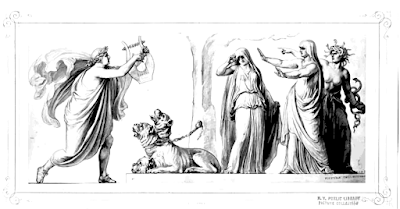 |
| Stones of Erasmus offers an Educational Download designed to teach the myth of Orpheus and Eurydice |
In the realm of English Language Arts (ELA), the ancient, tragic tale of the Greek myth of Orpheus and Eurydice offers a rich tapestry of themes and lessons for middle and high school students. Stones of Erasmus has created a comprehensive educational resource that provides an engaging, interactive, and distance-learning optimized approach to this timeless tale.
 |
| Orpheus enters the underworld. Image Credit: NYPL Digital Collections |
The story of Orpheus, the divine musician who loses his wife Eurydice twice, is a poignant exploration of love, loss, and the creative power of music and art. Our resource brings this myth to life in the classroom, whether virtual or physical, through a variety of activities and discussion prompts.
Over a three-day lesson plan, students will delve into the myth, analyze its characters and themes, and engage in critical thinking. The resource includes:
1. Art + Literature Connections: Students compare the myth with artwork by renowned artists like Auguste Rodin, fostering a deeper understanding of the story.
2. Reading Cards: This lesson is most effective when supplemented with diverse texts from Edith Hamilton's Mythology, Bulfinch's Mythology, and Ovid's Metamorphoses. However, the resource also includes an introductory dictionary entry on classic Greek and Roman mythology for a comprehensive start.
3. Reading Comprehension and Critical Thinking Questions: These questions encourage students to delve deeper into the text, promoting comprehension and critical thinking.
4. Frayer Model Vocabulary Cards: This visual approach to vocabulary helps students understand terms, geography, and challenging words in the context of the story.
5. Exit Tickets: These provide immediate feedback on students' understanding of the lesson, helping teachers adjust future instruction as needed.
6. Essay Writing Activity: This activity caps off the lesson, allowing students to express their understanding of the myth in a creative way.
Our resource aligns well with the Common Core Standards, particularly the reading literature standard that encourages the analysis of a subject or key scene in two different artistic mediums.
Whether used as a stand-alone lesson or paired with a larger unit on Myth, Percy Jackson and the Lightning Thief, Robert Graves’s Greek Myths, or Edith Hamilton’s Mythology, or Parallel Myths by J.F. Bierlein, this resource offers a comprehensive and engaging exploration of the tragic love story of Orpheus and Eurydice.
For more resources like this, visit the Stones of Erasmus TpT store, and join us on our journey to make ELA education more engaging and interactive.

